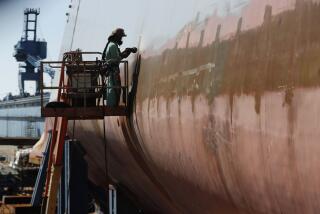Navy cancels new ships, says they are vulnerable
- Share via
WASHINGTON — The Navy took the unusual step of abruptly canceling construction of its expensive new class of destroyers last month because the ships lack abilities that top commanders believe are necessary to protect U.S. interests, according to the service’s senior officer.
Adm. Gary Roughead, chief of naval operations, said the DDG-1000 Zumwalt class destroyer does not have crucial missile and air defense capabilities and defending it against submarines would be difficult. The last ship in the class will cost $2.6 billion.
“I started looking at the DDG-1000. It has a lot of technology, but it cannot perform broader, integrated air and missile defense,” Roughead said in his first interview since the controversial move to cancel the destroyer program.
The Navy announced its abandonment of the Zumwalt class in July, after purchasing two ships, which are under construction. Under pressure from Congress, the Navy agreed to build a third, but it plans to drop the new destroyer after that, ending a 13-year push and returning to an earlier destroyer model.
The Navy once hoped to build 32 of the destroyers, named for the late Adm. Elmo R. Zumwalt Jr., the California-born officer who served as chief of naval operations in the 1970s. But Navy officials scaled the destroyer program back to seven and, finally, three.
The Zumwalt was conceived as a high-tech destroyer that would serve the Navy for 50 years. But some analysts have criticized it as a Cold War relic that is of little use to the modern Navy.
The Zumwalt class was designed to operate in coastal waters close to shore, but the Navy is developing a less costly ship for that.
Roughead also noted that design compromises resulted in the removal of some of its torpedoes, making it more vulnerable to submarines.
“Submarines can get very close, and it does not have the ability to take on that threat,” Roughead said.
The destroyer was originally designed as a ship that could move close to shore and fire its guns in support of ground forces. But Roughead said there is little call for the Navy to fire guns on shore.
“If you go back, from the end of Vietnam to our present time, we have only shot about a thousand bullets,” he said. “And I look at the world and I see proliferation of missiles, I see proliferation of submarines. And that is what we have to deal with.”
The Zumwalt class is also designed to be difficult for enemy radar to detect. But Roughead said the Navy was evaluating questions about that technology.
Correcting the air defense shortcomings would add billions of dollars to its cost, he said, making it prudent instead to build more of the previous-generation DDG-51 Arleigh Burke class destroyers. Additional models of the Arleigh Burke would cost about $1.8 billion apiece.
Sen. Susan Collins (R-Maine) led the fight to reverse the decision to cancel the Zumwalt class after two destroyers. The third destroyer had been scheduled to be built at General Dynamics’ Bath Iron Works in Maine. Collins complained that canceling the ship subverted the federal budget process and could cause a loss of jobs at the shipyard.
Roughead said the first two Zumwalt destroyers would help demonstrate the capabilities and problems of new technology in the ship, including its hull design and innovations designed to reduce the number of sailors needed to operate it.
But he was less enthusiastic about building a third ship. The Navy agreed to the additional vessel because money was already in the current budget proposal, he said.
“It will be another ship with which to demonstrate the technologies,” he said. “But it still will lack the capabilities that I think will be in increased demand in the future.”
Loren Thompson, a military analyst at the Lexington Institute who has criticized the Zumwalt class destroyers, said any ship operating close to shore to fire its guns would be vulnerable to attack from missiles.
The cost of the ship and its hull design have made it unpopular with the Navy, Thompson said, adding that the abrupt cancellation left many defense experts puzzled.
“How is it possible the Navy could spend a decade developing a multibillion-dollar destroyer, then suddenly discover the design is not suitable for its future needs?” he asked.
The Navy, which has 280 ships, is pushing for a 313-ship fleet, but shipbuilding problems are an obstacle.
Roughead said that shifting production from the Zumwalt to the Arleigh Burke class would allow him to build three more vessels.
“I am doing everything I can to increase the capability and capacity of the fleet,” Roughead said. “Shipbuilding dominates my thinking.”
--
More to Read
Sign up for Essential California
The most important California stories and recommendations in your inbox every morning.
You may occasionally receive promotional content from the Los Angeles Times.













